Complete Solutions to EXAMPLE of chapter ELECTROSTATICS of Class 12 book with complete answers and questions
| Class 12 | PHYSICS |
| Chapter | ELECTROSTATICS |
| TAMILNADU GOVT | EXAMPLE |
| Number Of Questions | 38 |
| Academic Year | 2023-24 |
Calculate the number of electrons in one coulomb of negative charge.
View SolutionConsider two point charges `q_1 and q_2` at rest as shown in the figure.
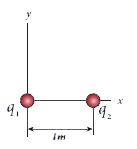
They are separated by a distance of 1m. Calculate the force experienced by the two charges for the following cases:
`q_1 = 2mu C and q_2 = + 3 mu C`
View SolutionConsider two point charges `q_1 and q_2` at rest as shown in the figure.
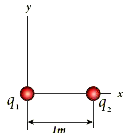
They are separated by a distance of 1m. Calculate the force experienced by the two charges for the following cases:
`q_1 = 2 mu C and q_2 = -3 mu C`
View SolutionConsider two point charges `q_1 and q_2` at rest as shown in the figure.
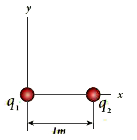
They are separated by a distance of 1m. Calculate the force experienced by the two charges for the following cases:
`q_1 = + 2 mu C and q_2 = -3 mu C` kept in water `(epsilon_(t) = 80)`
View SolutionTwo small-sized identical equally charged spheres, each having mass 1 mg are hanging in equilibrium as shown in the figure. The length of each string is 10 cm and the angle θ is 7° with the vertical. Calculate the magnitude of the charge in each sphere.
(Take `g = 10" ms"^(-2)` )
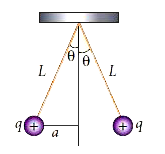
View SolutionCalculate the electrostatic force and gravitational force between the proton and the electron in a hydrogen atom. They are separated by a distance of `5.3 xx 10^(-11)` m. The magnitude of charges on the electron and proton are `1.6 xx 10^(-19)`C. Mass of the electron is `m_(e) = 9.1 xx 10^(-31)` kg and mass of proton is `m_(p) = 1.6 xx 10^(-27)` kg.
View SolutionConsider four equal charges `q_1 , q_2 , q_3 and q_4 = q = + 1 muC` located at four different points on a circle of radius 1m, as shown in the figure. Calculate the total force acting on the charge q1 due to all the other charges.
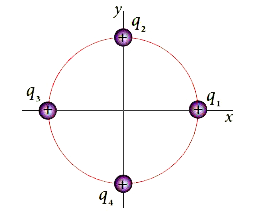
View SolutionCalculate the electric field at points P, Q for the following two cases, as shown in the figure.
A positive point charge `+ 1mu C` is placed at the origin
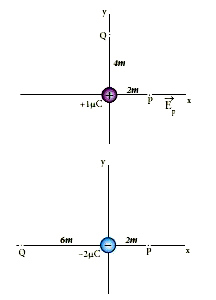
View SolutionCalculate the electric field at points P, Q for the following two cases, as shown in the figure.
A negative point charge `-2 mu C` is placed at the origin
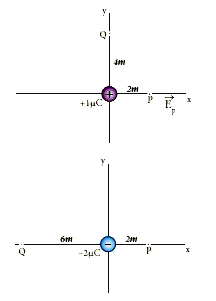
View SolutionConsider the charge configuration as shown in the figure. Calculate the electric field at point A. If an electron is placed at points A, what is the acceleration experienced by this electron? (mass of the electron `= 9.1 xx 10^(-31)` kg and charge of electron `= -1.6 xx 10^(-19)" C"`)
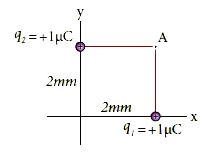
View SolutionA block of mass m and positive charge q is placed on an insulated frictionless inclined plane as shown in the figure. A uniform electric field E is applied parallel to the inclined surface such that the block is at rest. Calculate the magnitude of the electric field E.
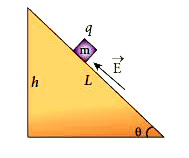
View SolutionThe following pictures depict electric field lines for various charge configurations.
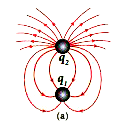
In figure (a) identify the signs of two charges and find the ratio `| (q_1)/(q_2) |`
View SolutionThe following pictures depict electric field lines for various charge configurations.

In figure (b), calculate the ratio of two positive charges and identify the strength of the electric field at three points A, B, and C
View SolutionThe following pictures depict electric field lines for various charge configurations.
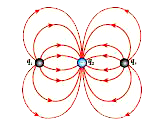
Figure (c) represents the electric field lines for three charges. If `q_2 = -20" nC"`, then calculate the values of `q_1 and q_3`.
View SolutionCalculate the electric dipole moment for the following charge configurations.
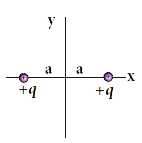
View SolutionCalculate the electric dipole moment for the following charge configurations.
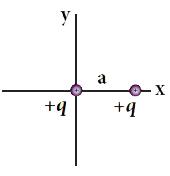
View SolutionCalculate the electric dipole moment for the following charge configurations.
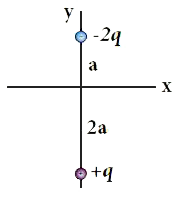
View SolutionCalculate the electric dipole moment for the following charge configurations.
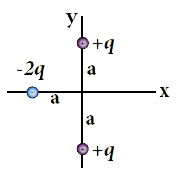
View SolutionA sample of HCl gas is placed in a uniform electric field of magnitude `3 xx 10^(4)" N C"^(-1)`. The dipole moment of each HCl molecule is `3.4 xx 10^(-30)` Cm. Calculate the maximum torque experienced by each HCl molecule.
View SolutionCalculate the electric potential at points P and Q as shown in the figure below.

View SolutionSuppose the charge `+9muC` is replaced by `-9muC` find the electrostatic potentials at points P and Q

View SolutionCalculate the work done to bring a test charge `2mu C` from infinity to the point P. Assume the charge `+ 9 mu C` is held fixed at origin and `+ 2 mu C` is brought from infinity to P.

View SolutionConsider a point charge +q placed at the origin and another point charge -2q placed at a distance of 9 m from the charge +q. Determine the point between the two charges at which electric potential is zero.
View SolutionThe following figure represents the electric potential as a function of x – coordinate. Plot the corresponding electric field as a function of x.
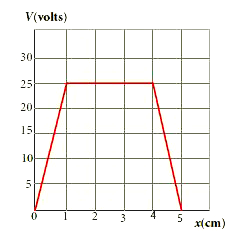
View SolutionFour charges are arranged at the corners of the square PQRS of side a as shown in the figure.
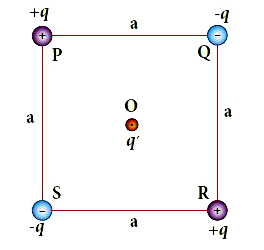
Find the work required to assemble these charges in the given configuration.
View SolutionFour charges are arranged at the corners of the square PQRS of side a as shown in the figure.
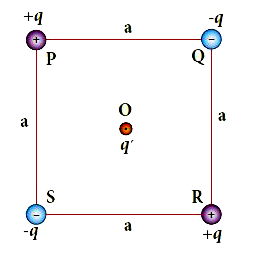
Suppose a charge q′ is brought to the center of the square, by keeping the four charges fixed at the corners, how much extra work is required for this?
View SolutionA water molecule has an electric dipole moment of `6.3 xx 10^(-30)` Cm. A sample contains `10^(22)` water molecules, with all the dipole moments aligned parallel to the external electric field of magnitude `3 xx 10^(5)"N C"^(-1)`. How much work is required to rotate all the water molecules from `theta = 0^(@)` to `90^@`?
View SolutionCalculate the electric flux through the rectangle of sides 5 cm and 10 cm kept in the region of a uniform electric field 100 `"N C"^(-1)`. The angle `theta` is `60^@`. Suppose `theta` becomes zero, what is the electric flux?
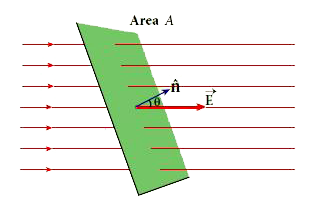
View Solution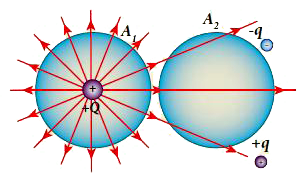
In figure , calculate the electric flux through the closed areas `A_1 and A_2`.
View Solution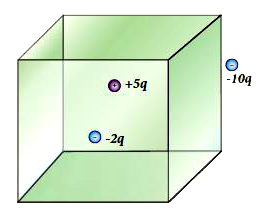
In figure , calculate the electric flux through the cube
View SolutionA small ball of conducting material having a charge +q and mass m is thrown upward at an angle `theta` to horizontal surface with an initial speed `v_o` as shown in the figure. There exists an uniform electric field E downward along with the gravitational field g. Calculate the range, maximum height and time of flight in the motion of this charged ball. Neglect the effect of air and treat the ball as a point mass.

View SolutionA parallel plate capacitor has square plates of side 5 cm and separated by a distance of 1 mm.
Calculate the capacitance of this capacitor.
View SolutionA parallel plate capacitor has square plates of side 5 cm and separated by a distance of 1 mm.
If a 10 V battery is connected to the capacitor, what is the charge stored in any one of the plates? (The value of `epsilon_(o) = 8.85 xx 10^(-12)"Nm"^(2)"C"^(-2)`)
View SolutionA parallel plate capacitor filled with mica having `epsilon_(r) = 5` is connected to a 10 V battery. The area of the parallel plate is `6m^2` and separation distance is 6 mm.
Find the capacitance and stored charge.
View SolutionA parallel plate capacitor filled with mica having `epsilon_(r) = 5` is connected to a 10 V battery. The area of the parallel plate is `6m^2` and separation distance is 6 mm.
After the capacitor is fully charged, the battery is disconnected and the dielectric is removed carefully.
Calculate the new values of capacitance, stored energy and charge.
View SolutionFind the equivalent capacitance between P and Q for the configuration shown below in the figure (a).

View SolutionTwo conducting spheres of radius `r_1 = 8cm and r_2 = 2 cm` are separated by a distance much larger than 8 cm and are connected by a thin conducting wire as shown in the figure. A total charge of `Q =+ 100" nC"` is placed on one of the spheres. After a fraction of a second, the charge Q is redistributed and both the spheres attain electrostatic equilibrium.

(a). Calculate the charge and surface charge density on each sphere.
(b). Calculate the potential at the surface of each sphere.
View SolutionDielectric strength of air is `3 xx 10^(6)"V m"^(-1)`. Suppose the radius of a hollow sphere in the Van de Graff generator is R = 0.5 m, calculate the maximum potential difference created by this Van de Graaff generator.
View Solution
EXAMPLE questions and complete solutions for chapter ELECTROSTATICS of FULL MARKS PHYSICS(TAMIL) of Class 12